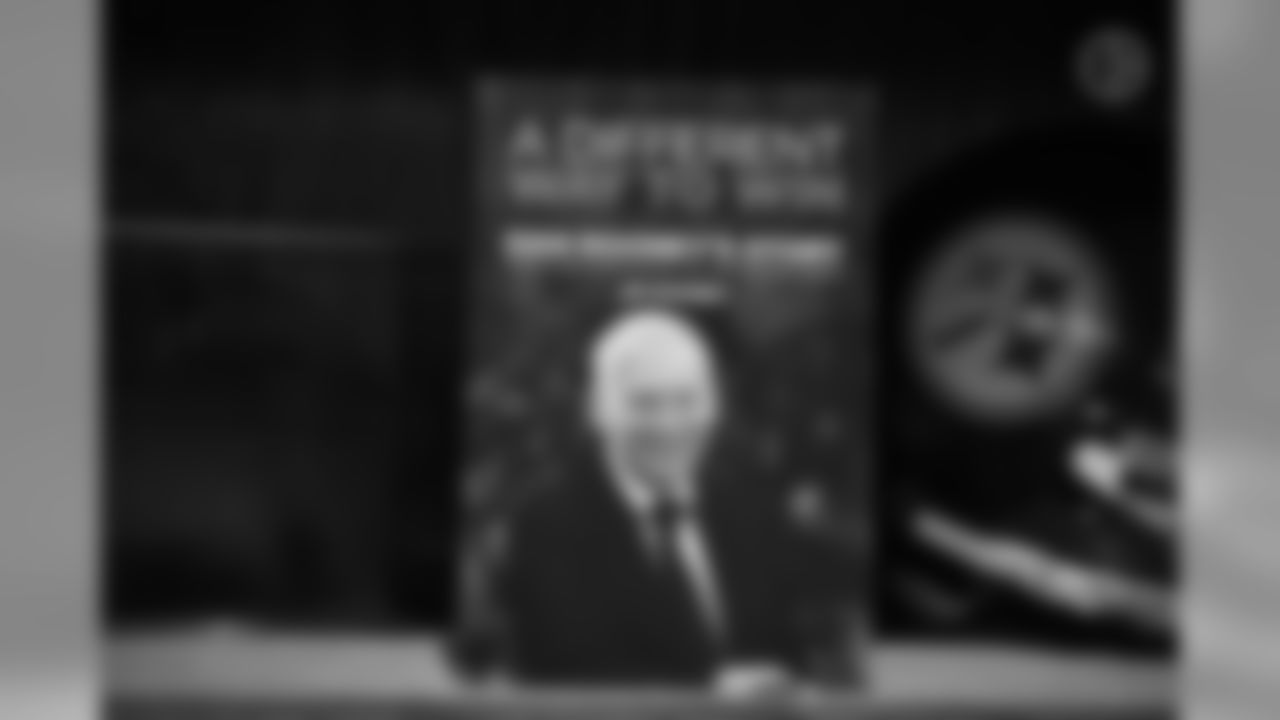Ready or not, here it comes:
• "(T)here's a short list of people who have helped the National Football League live up to its creed: To honor everyone, the fans, the players, and all the teams. Dan Rooney was one of those people. And he was like that in all the other roles he played, as a father, a business leader, a philanthropist, and a peacemaker. Everywhere Dan Rooney went, he was revered. And this book will tell you why."
• That's the conclusion of the Foreword, done by Joe Greene, that sets up what's to come in the book authored by his son, Jim Rooney, and titled, "A Different Way To Win: Dan Rooney's Story from the Super Bowl to the Rooney Rule." And once you've completed the 200-plus pages, I'm confident the reasons why Dan Rooney was revered will have been made clear.
• Because Dan Rooney is so well known to so many people for so many reasons, the author spent a couple of pages following Greene's Foreword explaining the points the rest of the narrative will attempt to get across. Typically, that wouldn't be necessary, but when a book is advertised as being about Dan Rooney, there justifiably would be questions about whether it's a sports book that focuses on the Pittsburgh Steelers, a sports book that chronicles the rise of the NFL to its current status as America's true national pastime, a book about the life of a diplomat in a foreign country and the peace process in Ireland, or a book about the Rooney Rule.
>>> Pre-Order Now
• As the author explains, this book touches on all of those topics, and the Table of Contents reflects that. The complete text is divided into four "stories." Story I is titled, "Steward: Faith, Family, Football." Story II is titled, "Architect: The Steelers of the 1970s." Story III is titled, "Peacemaker: Ireland." And Story IV is titled, "Vocation: His Life's Work – The Rooney Rule."
• And as is the case with everything touched upon within the book, the emphasis, the common thread, is the one principle that seemed to be the guiding light throughout Dan Rooney's entire professional life: "do the right thing."
• "If you were to choose one word to describe who he was and how he carried himself no matter the setting, that word would have to be authenticity," writes Jim Rooney. "He was who he was, and he didn't try to be who he wasn't. People respected that, and some even loved him for it. He didn't play the role of Dan Rooney. He was Dan Rooney."
• It's a safe assumption that many of those who will be drawn to "A Different Way To Win" will be those interested in how Dan Rooney's management style and fundamental belief of always trying to do the right thing transformed Pittsburgh's professional football team.
• "The truth was, by the time Dan got involved," writes Jim Rooney, "he couldn't have made things much worse. My grandfather was a beloved local figure, so the Steelers bore the label of 'lovable losers. But losers they were."
• "A Different Way To Win" takes the reader through many of the significant events in NFL history that would shape the future of the league – the election of Pete Rozelle as Commissioner, the impact of television and the NFL's forward-thinking policy of sharing that revenue equally among all teams, the war with the AFL and the subsequent merger, the creation of the Super Bowl – and Dan Rooney's impact and influence on each of those events.
• The book states that Art Rooney Sr.'s one glaring mistake during his tenure as an NFL owner was not challenging "the unofficial agreement among NFL owners to ban black players." That turns into the main issue addressed in Story II, which begins with January 1980 at the Rose Bowl in Pasadena, California.
>>> Pre-Order Now
Jim Rooney is the son of the late Pittsburgh Steelers Chairman and President Dan Rooney, who also served as U.S. Ambassador to Ireland during the Obama Administration. There was a press conference on Tuesday at the UPMC Rooney Sports Complex to announce a book authored by Jim Rooney, titled, "A Different Way To Win: Dan Rooney's Story, from the Super Bowl to the Rooney Rule." The book is described as part business bio, part memoir, and part history.

Jim Rooney, son of the late Dan Rooney, held a press conference at the UPMC Rooney Sports Complex revealing a book he authored, titled, "A Different Way To Win." Telling of his father's life story.


Jim Rooney, son of the late Dan Rooney, held a press conference at the UPMC Rooney Sports Complex revealing a book he authored, titled, "A Different Way To Win." Telling of his father's life story.


Jim Rooney, son of the late Dan Rooney, held a press conference at the UPMC Rooney Sports Complex revealing a book he authored, titled, "A Different Way To Win." Telling of his father's life story.


Jim Rooney, son of the late Dan Rooney, held a press conference at the UPMC Rooney Sports Complex revealing a book he authored, titled, "A Different Way To Win." Telling of his father's life story.


Jim Rooney, son of the late Dan Rooney, held a press conference at the UPMC Rooney Sports Complex revealing a book he authored, titled, "A Different Way To Win." Telling of his father's life story.
• "The Steelers wore their traditional black jerseys with white numbers, and over the previous decade the uniform had become symbolic," writes Jim Rooney. "The integration of the team during the 1970s had been purposeful, a keystone of Dan Rooney's leadership of the Steelers. Joe Greene, who went to a segregated high school in Texas, anchored the front of the Steel Curtain defense. Buttressing Greene were future Hall of Famers Jack Ham and Jack Lambert, two white linebackers from the Rust Belt. Behind them were Mel Blount and Donnie Shell, both of whom had attended historically black colleges and universities (HBCUs) and marched in the South after Martin Luther King's assassination. The final line of defense was Mike Wagner, a white safety from a town situated between Milwaukee and Chicago."
• This section of the book takes the reader through every phase of the Steelers' transformation, and how it started with Dan Rooney's detailed plan to turn the Steelers into champions on the field but also an organization that attained greatness in the community, in the outside world, and in their thinking.
• "Then he wrote very specifically what he expected each person within the organization to do," writes Jim Rooney. "This plan was his design for the entirety of the franchise. The document was always in the credenza behind his desk, and he would refer to it often. It described in detail every activity for which the franchise was responsible. He wrote out the obligations and objectives of each role, from ball boy to business managers to coaches."
• This section also explains Dan Rooney's collaboration with the three people identified by the book as integral to the execution of his plan: Bill Nunn, Chuck Noll, and Joe Gordon. The scout who identified the talent, the coach who molded that talent into a championship team, and the public relations man who nurtured the Steelers brand.
• The section on Ireland is neither boring nor difficult to understand, nor does it require an in-depth knowledge of the history of violence in that country and the reasons for it. While it's not about football, this section reinforces much of what was covered earlier in the book about Dan Rooney's work with the NFL, primarily in the area of labor, because it recounts his knack for finding a consensus among people who very likely are going to end up not being totally happy with the final agreement.
• The final section of the book deals with the Rooney Rule, which began as a requirement that any NFL team hiring a head coach to interview at least one minority candidate for the job. It since has expanded to include senior football operations jobs, including general managers. The impact of the rule is detailed in the book with a powerful illustration that shows the number of minority coaches hired before the creation of the Rooney Rule vs. the hirings coming after its implementation.
• This section had the potential to devolve into a dry, overly academic recounting, but instead of simply citing statistics, the section on the Rooney Rule includes enough story-telling with a number of easily recognizable NFL power-brokers as main characters to keep the reader interested and the pages turning. It's history, but it's delivered in a more anecdotal, less academic, way, while still impressing upon the reader the importance of the Rooney Rule and the delicate negotiating touch that was required to get it approved by ownership.
• To quote from the text: "A change in approach this significant is difficult in the NFL, as it is in any organization. And there would be some resistance. (Dan) Rooney had been wrestling with how to make changes and how to convince others to join him in those changes throughout his life … Dan Rooney would bring all of those qualities – the credibility he had built in the NFL, the ability to forge common ground, and his willingness to immerse himself in the nitty-gritty of the process and continue to be a champion for what he believed in – to improve opportunities for minority coaches in the NFL. The Rooney Rule would be the culmination of his life's work and his professional approach."
• Call it Dan Rooney's gift, or his genius, but his ability to bring together people on opposing sides of an often contentious issue and broker a peaceful solution is a great contribution, and his willingness to do that in a selfless and respectful way is what made him a great man.
• Early in the book, Jim Rooney tells the reader that "A Different Way To Win" will illustrate why Dan Rooney was revered, no matter where he went and in what field of endeavor he had immersed himself. By the end, the book delivers on that promise.
>>> Pre-Order Now














